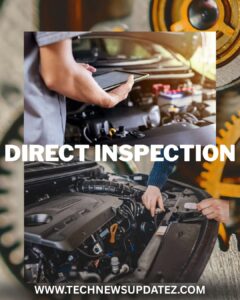Buying a used car (second-hand) in the market can feel overwhelming for many people, especially if you don’t have someone knowledgeable to guide you. So, what should you do?
Don’t worry – here’s a set of simple, easy to understand steps to help you confidently inspect and purchase a used car all by yourself.
Introduction:
Nowadays, cars have become an essential part of our daily lives. While many people can’t afford a brand- new car, they can often manage to buy a used one. The real challenge, however, lies in knowing how to check and buy a used car.
You might wonder, “Why should I check it myself? There are so many mechanics in the market can’t I just ask one of them to do it?”
Yes, that is indeed the first and most common option. But here’s the truth – it doesn’t always work out. And there are reasons why?
If you are looking for a used car, you will likely spend time every day checking what’s available in the market. On some days you might come across two or three cars that catch your attention. Eventually, you may find one that looks promising. But, how do you know if it’s actually a good car?
That’s usually the point when you seek the help of an expert. You call a mechanic, they inspect the car, and then tell you whether it’s worth buying or not. Sounds simple? but what is the mechanic isn’t available at the time? There’s a high chance the car could be sold to another buyer before you get it checked.
Even if the mechanic is available, each visit comes at a cost – for example, Rs. 1000 to Rs. 2000 per inspection. This means you start spending money before you have even decided on the final car, and it takes multiple inspections to find the right one, those costs quickly add up.
To save both your time and money, you can learn to do a basic car inspection yourself. The following guide is designed just for you, with simple and clear steps you can follow without depending on others.
There are 2 main stages of inspection when buying a used car:
Step 1 : Background Check (Indirect verification)
Step 2 : Physical Inspection (Direct verification)
- External inspection
- Internal inspection
STEP 1: BACKGROUND CHECK (Indirect)
Why is this verification necessary?
What exactly is Indirect verification? Simply put, it means not blindly trusting a car based on its appearance. It refers checking the car’s documents and papers before you even see it in person.
This method can save you both time and money. For example, if you find a used car you are interested in, don’t rush to the seller’s location right away. Instead, perform a background check while sitting comfortably at home. This way, you can quickly identify whether the car is worth your effort before spending time and travel costs.

Tip: Avoid choosing cars that are 15 years old or close to 14 years old. Such vehicles require a Fitness Certificate (FC) from the RTO to remain road legal. If any car in your options falls in this age range, think twice before proceeding (This advice is for educational purposes only)
Indirect verification steps
1. Ask the seller to send you clear images of the car and Soft copies of its documents via WhatsApp or email. Review the photos carefully for visible scratches, dents, or signs of damages.
2. Make sure the seller provides the following required documents:
- RC Book (Registration Certificate)
- Insurance Copy
- Pollution Under Control (PUC) Certificate
- Car Service Records
- Loan Status Report (to check if the car is under any finance or hypothecation)
3. Check the Registration Number & Owner’s Name to Confirm that the car’s number plate matches the details in the RC Book and ensure the owner’s name in the RC Book is the same as the seller’s.
4.Verify RC Book Details Online and Cross-check details like brand name, number of owners, model year, color, and registration validity using the official VAHAN portal: https://vahan.parivahan.gov.in/
5.Check Insurance Status & Claims History and ensure whether the insurance policy is currently active also Investigate any previous insurance claims made for the vehicle (this can hint at past accidents or major repairs).
6.Review Service Records and contact the car’s authorized service center and request details of past services. Also, check how regularly the car has been serviced and if any major repairs were done.
7.Check Loan / Finance Status to verify whether any loan is still active on the car. If the loan is closed, ensure the RC Book reflects the current owner’s name instead of the finance company’s name. You can also request for a No Objection Certificate (NOC) if needed.
Once you have completed all these indirect checks yourself, you can move on confidently to the Direct Inspection stage.
Read Also:https://technewsupdatez.com/how-to-choose-car-brands-and-models-in-2025/
Step 2: PHYSICAL INSPECTION (Direct)
When buying a used (second-hand) car, direct physical inspection is absolutely mandatory. Never confirm the purchase or pay any advance before you have personally inspected the vehicle.
Do not rely solely on car photos or edited videos. Appearance can be deceiving. A car may look perfect in pictures but have hidden issues in real life.
The following steps will help you inspect a used car without any technical expertise, so you can confidently judge its condition before making a decision.

Easy steps anyone can follow
Before inspecting the car physically, start with some important questions. Many buyers skip these, but they can reveal a lot about the car’s history.
Questions to ask the seller:
- Why are you selling this car – Common answers might be:
– Upgrading to a new vehicle or
– Needing an urgent sale due to financial reasons. - Usage history:
– When was the last time you took this car on a long trip?
– How many kilometers did you drive continuously? - Mileage: What is the exact mileage you’re getting these days?
- Servicing:
– After how many kilometers do you usually service this car?
– What was the cost of the last service?
– Were any major components replaced, such as engine work or transmission repairs? - Damage history: Has this car ever been in an accident or suffered flood damage?
Other important Checks
- Ownership & Usage –
– Ask how many years the seller has owned this car and
– How many people have driven it. - If it was primarily driven by a woman driver, there’s a higher chance it was handled gently without aggressive driving.
- Driving Environment
– Find out the primary location where the car was used.
– Cars used near coastal areas (beach regions) may have more corrosion on the underbody due to salt air. - Exterior Condition
– Walk around the car and
– Carefully inspect for scratches, dents, or damage.
– Take photos of any visible issues — these can help you negotiate the price later.
Tip: If you are unsure about any of these checks, you can always take the help of a mechanic or car expert for additional verification.
A. EXTERNAL INSPECTION
These checks will help you spot visible and basic mechanical issues before committing to a purchase.

- Start the Car in Neutral and
– Listen carefully when starting the engine.
– If it starts with a single turn of the key, it’s a good sign.
– If it takes 2–3 attempts, the battery or engine health may need attention. - Listen to the Engine Sound (3–5 Minutes)
– Keep the engine running and listen for any unusual knocking, cracking, or rattling noises.
– A smooth, consistent sound usually indicates a healthy engine. - Check the Engine Bay (Bonnet Area)
– Open the bonnet and see if the engine area is clean and well-maintained.
– Excessive dirt, oil stains, or rust may signal poor maintenance. - Inspect the Battery
– Look for any white or greenish deposits around the battery terminals. These indicate corrosion.
– Check the battery’s purchase date; most batteries last 3–5 years. - Check the Radiator
– Locate the radiator (it’s attached to the fan).
– Ensure it’s clean and free from leaks or rust. - Verify the Chassis Number
– If the chassis number is visible in the bonnet area, confirm it matches the RC Book details. - Check Engine Oil Level
– Pull out the dipstick, wipe it, insert it again, and then check the oil level.
– Oil should be between the “Low” and “High” marks and should not be overly dirty or black. - Observe Exhaust Smoke – While the engine is running, check the exhaust pipe.
Light white smoke – usually normal and can be fixed easily.
Black smoke – may indicate low engine oil or incomplete combustion (needs further checking). - Inspect Under the Chassis – Look underneath the car for oil leaks, rust, or visible damage to the underbody.
- Check All Tires (Including Spare tire/Other Spares)
– Inspect tread depth and look for the TWI – Tread Wear Indicator.
– Uneven wear may indicate alignment or suspension issues.
B. INTERNAL INSPECTION
These checks will help you understand the car’s condition from the inside and ensure everything works smoothly before you buy.

- Start the Car & Check the Dashboard and Notice how smoothly the engine starts.
- Look at the odometer and warning lights
– Pay attention to the “Check Engine” light or any other alerts. - Verify the Odometer Reading
– Compare the displayed kilometers with the last service record.
– If the car is close to its next service interval, keep that in mind for upcoming maintenance costs. - Test the Air Conditioner (AC)
– Turn it on and check how quickly it cools the cabin.
– Weak cooling could mean gas refilling or AC repairs are needed. - Check the Steering
– While the engine is running, turn the steering wheel fully right and left.
– It should move smoothly without unusual noises or stiffness. - Test All Electronic Controls
– Switch on the lights, indicators, wipers, power windows, infotainment system, etc.
– Make sure they work without causing the engine to strain or make unusual sounds. - Inspect the Clutch
– Press the clutch pedal — it should feel smooth and not overly hard.
– A hard or jerky clutch may need inspection or replacement. - Check the Gearbox
– Shift through all gears in sequence. They should engage smoothly without resistance.
– If shifting feels hard, it could mean gearbox issues. - Test Suspension & Shock Absorbers
– Drive the car over small bumps or uneven surfaces.
– A well-maintained suspension will absorb shocks without rattles or harsh bumps. - Take a Test Drive
– This is the most important step.
– While driving, notice if there are any vibrations, jerks, pulling to one side, or strange noises.
Tip: If you find issues during your inspection, point them out to the seller. These can be useful for negotiating the price.
Conclusion:
These inspection steps cover the most important areas for used car buyers. Many of these components are costly to repair and wear out over time, so catching problems early can save you a lot of money.
There are more technical checks, but they may be difficult for beginners. If you’re unsure at any step, seek help from a trusted mechanic.
With this guide, you can confidently perform your own used car inspection, make informed decisions, and negotiate a fair price all while saving time and money.
Read Also:https://technewsupdatez.com/used-car-vs-new-car-which-is-bestbuyers-option-guide/
